Preparation and Physico-Chemical Performance Optimization of Sintering-Free Lightweight Aggregates with High Proportions of Red Mud
Abstract
:1. Introduction
2. Experimental
2.1. Raw Materials and Characterization
2.2. Preparation of Solid Waste-Based Binder
2.3. Preparation of RM-Based SFLAs
2.4. Characterization of Solid Waste-Based Binder Materials and RM-Based SFLAs
2.4.1. Performance Test of Solid Waste-Based Binder Materials
2.4.2. Performance Test of RM-Based SFLAs
2.4.3. Mineral Phases Analyzes of Binder Materials and RM-Based SFLAs
2.5. Microstructure of Binder Materials and RM-Based SFLAs
2.6. Heavy Metal Leaching Test of RM-Based SFLAs
3. Results and Discussion
3.1. Properties of Solid Waste-Based Binder Materials
3.2. Physical Performance of RM-Based SFLAs
3.2.1. Particle Size Distribution
3.2.2. Bulk Density and Apparent Density
3.2.3. Cylinder Compressive Strength
3.2.4. Water Absorption
3.3. XRD Analysis of RM-Based SFLAs
3.4. Microstructure. Analysis of RM-Based SFLAs
3.5. Leaching Behavior of RM-Based SFLAs
3.6. Comparison between RM-Based SFLAs and Conventional LAs
4. Conclusions
- (1)
- It is feasible to use a high proportion of red mud to prepare RM based on SFLAs by using the pelletizing technique, and solid waste-based binder can be used as an alternative cementitious material, having excellent compatibility with RM in preparation of RM based on SFLAs. Moreover, the present study demonstrates a new SFLAs preparation method based totally on solid wastes.
- (2)
- The columnar ettringite is lapped to form a skeleton structure, and gel by hydration and unhydrated red mud particles cemented or filled in the skeleton. This structure increases the compactness of SFLAs, which is the fundamental reason for the high strength of RM based on SFLAs. Therefore, the binder can be used as a substitute for Portland cement to produce SFLAs.
- (3)
- The raw materials for the preparation of SFLAs were all from industrial solid waste, which greatly reduced the preparation cost of SFLAs and environmental problems caused by the massive storage of RM. The optimal matching of binder/RM was 3:7, and the prepared SFLAs had a 28 d cylinder compressive strength of 11.3 MPa, bulk density of 900–1000 kg·m−3, and water absorption of less than 10%. It provides a theoretical basis for the preparation and application of red mud-based aggregate, which can be used for the preparation of lightweight aggregate concrete and roadbed fillers, etc., with broad application prospects.
- (4)
- The concentration of heavy metals leached from SFLAs is lower than the toxic leaching standard for building materials. Besides, as the hydration age increases, the number of chromium ions leached from the red mud aggregates will decrease, because ettringite produced by hydration of the binder material has a good stabilizing effect on Cr and demonstrates good environmental compatibility. Therefore, RM-based SFLAs have good environmental acceptable, and will not cause secondary pollution to the environment.
- (5)
- Compared with conventional LAs, RM based on SFLAs has the advantages of a simple preparation process, lower cost, and better performance than conventional LAs, which further proves that the red mud combined with binder material to prepare red mud aggregate is an effective way to recycle red mud.
Author Contributions
Funding
Institutional Review Board Statement
Informed Consent Statement
Data Availability Statement
Acknowledgments
Conflicts of Interest
References
- Kirwan, L.-J.; Hartshorn, A.; McMonagle, J.-B.; Fleming, L.; Funnell, D. Chemistry of Bauxite Residue Neutralisation and Aspects to Implementation. Int. J. Miner. Process. 2013, 119, 40–50. [Google Scholar] [CrossRef]
- Liu, W.; Chen, X.; Li, W.; Yu, Y.; Yan, K. Environmental Assessment, Management and Utilization of Red Mud in China. J. Clean. Prod. 2014, 84, 606–610. [Google Scholar] [CrossRef]
- Liu, W.; Yang, J.; Xiao, B. Review on Treatment and Utilization of Bauxite Residues in China. Int. J. Miner. Process. 2009, 93, 220–231. [Google Scholar] [CrossRef]
- Wang, W.; Pranolo, Y.; Cheng, C. Recovery of Scandium from Synthetic Red Mud Leach Solutions by Solvent Extraction with D2EHPA. Sep. Purif. Technol. 2013, 108, 96–102. [Google Scholar] [CrossRef]
- Alam, S.; Das, S.-K.; Rao, B.-H. Characterization of Coarse Fraction of Red Mud as a Civil Engineering Construction Material. J. Clean. Prod. 2017, 168, 679–691. [Google Scholar] [CrossRef]
- Power, G.; Gräfe, M.; Klauber, C. Bauxite Residue Issues: I. Current Management, Disposal and Storage Practices. Hydrometallurgy 2011, 108, 33–45. [Google Scholar] [CrossRef]
- Ujaczki, É.; Zimmermann, Y.-S.; Gasser, C.-A.; Molnár, M.; Feigl, V.; Lenz, M. Red Mud as Secondary Source for Critical Raw Materials-Extraction Study. J. Chem. Technol. Biotechnol. 2017, 92, 2835–2844. [Google Scholar] [CrossRef]
- Claudia, B.; Carlo, C.; Paolo, M.; Valentina, P.; Leonardo, T. Reuse of a Treated Red Mud Bauxite Waste: Studies on Environmental Compatibility. J. Hazard. Mater. 2005, 117, 55–63. [Google Scholar]
- Wu, C.; Liu, D. Stockpiling and Comprehensive Utilization of Red Mud Research Progress. Materials 2012, 5, 1232–1246. [Google Scholar]
- Wang, S.; Ang, H.-M.; Tadé, M.-O. Novel Applications of Red Mud as Coagulant, Adsorbent and Catalyst for Environmentally Benign Processes. Chemosphere 2008, 72, 1621–1635. [Google Scholar] [CrossRef]
- Wang, W.; Chen, W.; Liu, H.; Han, C. Recycling of Waste Red Mud for Production of Ceramic Floor Tile with High Strength and Lightweight. J. Alloy. Compd. 2018, 748, 876–881. [Google Scholar] [CrossRef]
- Du, Y.; Dai, M.; Cao, J.; Peng, C. Fabrication of a Low-Cost Adsorbent Supported Zero-Valent Iron by Using Red Mud for Removing Pb(ii) and Cr(vi) from Aqueous Solutions. RSC Adv. 2019, 9, 33486–33496. [Google Scholar] [CrossRef] [Green Version]
- Ghalehnovi, M.; Shamsabadi, E.-A.; Khodabakhshian, A.; Sourmeh, F.; Brito, J. Self-Compacting Architectural Concrete Production Using Red Mud. Constr. Build. Mater. 2019, 226, 418–427. [Google Scholar] [CrossRef]
- Zhang, J.; Li, P.; Liang, M.; Jiang, H.; Yao, Z.; Zhang, X.; Yu, S. Utilization of Red Mud as an Alternative Mineral Filler in Asphalt Mastics to Replace Natural Limestone Powder. Constr. Build. Mater. 2020, 237, 117821. [Google Scholar] [CrossRef]
- He, H.; Yue, Q.; Su, Y.; Gao, B.; Gao, Y.; Wang, J.; Yu, H. Preparation and Mechanism of the Sintered Bricks Produced from Yellow River Silt and Red Mud. J. Hazard. Mater. 2011, 203, 53–61. [Google Scholar] [CrossRef]
- Wang, L.; Sun, N.; Tang, H.; Sun, W. A Review on Comprehensive Utilization of Red Mud and Prospect Analysis. Minerals 2019, 9, 362. [Google Scholar] [CrossRef] [Green Version]
- Thomas, J.; Harilal, B. Properties of Cold Bonded Quarry Dust Coarse Aggregates and Its Use in Concrete. Cem. Concr. Compos. 2015, 62, 67–75. [Google Scholar] [CrossRef]
- Li, Y.; Huang, H.; Xu, Z.; Ma, H.; Guo, Y. Mechanism Study on Manganese (II) Removal from Acid Mine Wastewater Using Red Mud and Its Application to a Lab-Scale Column. J. Clean. Prod. 2020, 253, 119955. [Google Scholar] [CrossRef]
- Gesoğlu, M.; Güneyisi, E.; Mahmood, S.-F.; Öz, H.-Ö.; Mermerdaş, K. Recycling Ground Granulated Blast Furnace Slag as Cold Bonded Artificial Aggregate Partially Used in Self-Compacting Concrete. J. Hazard. Mater. 2012, 235, 352–358. [Google Scholar] [CrossRef]
- Cioffi, R.; Colangelo, F.; Montagnaro, F.; Santoro, L. Manufacture of Artificial Aggregate Using MSWI Bottom Ash. Waste Manag. 2010, 31, 281–288. [Google Scholar] [CrossRef]
- Sadique, M.; Nageim, H.A.; Atherton, W.; Seton, L.; Dempster, N. Analytical Investigation of Hydration Mechanism of a Non-Portland Binder with Waste Paper Sludge Ash. Constr. Build. Mater. 2019, 211, 80–87. [Google Scholar] [CrossRef]
- Liu, W.; Yang, J.; Xiao, B. Application of Bayer Red Mud for Iron Recovery and Building Material Production from Alumosilicate Residues. J. Hazard. Mater. 2008, 161, 473–478. [Google Scholar] [CrossRef] [PubMed]
- Cheng, X.; Long, D.; Zhang, C.; Gao, X.; Yu, Y.; Mei, K.; Zhang, C.; Guo, X.; Chen, Z. Utilization of Red Mud, Slag and Waste Drilling Fluid for the Synthesis of Slag-Red Mud Cementitious Material. J. Clean. Prod. 2019, 238, 117902. [Google Scholar] [CrossRef]
- Shafigh, P.; Chai, L.-J.; Mahmud, H.-B. A comparison Study of the Fresh and Hardened Properties of Normal Weight and Lightweight Aggregate Concretes. J. Build. Eng. 2018, 15, 252–260. [Google Scholar] [CrossRef]
- Tang, P.; Florea, M.-A.; Brouwers, H.-J. Employing Cold Bonded Granulation to Produce Lightweight Aggregates from Incineration Fine Bottom Ash. J. Clean. Prod. 2017, 165, 1371–1384. [Google Scholar] [CrossRef]
- Li, Y.; Li, J.; Guo, H. Preparation and Study of Light Transmitting Properties of Sulfoaluminate Cement-Based Materials. Mater. Des. 2015, 83, 185–192. [Google Scholar] [CrossRef]
- Yao, X.-L.; Wang, W.-L.; Liu, M.; Yao, Y.-G.; Wu, S. Synergistic Use of Industrial Solid Waste Mixtures to Prepare Ready-to-Use Lightweight Porous Concrete. J. Clean. Prod. 2019, 211, 1034–1043. [Google Scholar] [CrossRef]
- Ren, C.-Z.; Wang, W.-L.; Li, G. Preparation of High-Performance Cementitious Materials from Industrial Solid Waste. Constr. Build. Mater. 2017, 152, 39–47. [Google Scholar] [CrossRef]
- Su, D.; Yue, G.; Li, Q.; Guo, Y.; Gao, S.; Wang, L. Research on the Preparation and Properties of High Belite Sulphoaluminate Cement (HBSAC) Based on Various Industrial Solid Wastes. Materials 2019, 12, 1510. [Google Scholar] [CrossRef] [Green Version]
- Test Methods for Water Requirement of Normal Consistency, Setting Time and Soundness of Sulfur-Aluminum Cement; GB/T 20472-2006; General Administration of Quality Supervision, Inspection and Quarantine of the People’s Republic of China, Standardization Administration of China: Beijing, China, 2006.
- Test Methods for Mortar Strength of Sulfur-Aluminum Cement; GB/T 17671-1999; General Administration of Quality Supervision, Inspection and Quarantine of the People’s Republic of China, Standardization Administration of China: Beijing, China, 1999.
- Test Methods for Cylinder Compressive Strength, Water Absorption, Bulk Density and Apparent Density of Lightweight Aggregate; GB/T 17431.2-2010; General Administration of Quality Supervision, Inspection and Quarantine of the People’s Republic of China, Standardization Administration of China: Beijing, China, 2010.
- Yao, Y.G.; Wang, W.L.; Ge, Z.; Ren, C.Z. Hydration Study and Characteristic Analysis of a Sulfoaluminate High-Performance Cementitious Material Made with Industrial Solid Wastes. Cem. Concr. Compos. 2020, 112, 103687. [Google Scholar] [CrossRef]
- Solid waste Toxicity Leaching Method: Horizontal Oscillation Method; HJ 557-2010; General Administration of Quality Supervision, Inspection and Quarantine of the People’s Republic of China, Standardization Administration of China: Beijing, China, 2010.
- Hazardous Waste Identification Standard; GB/T 5085.3-2007; General Administration of Quality Supervision, Inspection and Quarantine of the People’s Republic of China, Standardization Administration of China: Beijing, China, 2007.
- Jain, N.; Garg, M. Effect of Cr (VI) on the Hydration Behavior of Marble Dust Blended Cement: Solidification, Leachability and XRD Analyses. Constr. Build. Mater. 2008, 22, 1851–1856. [Google Scholar] [CrossRef]
- Chrysochoou, M.; Dermatas, D. Evaluation of Ettringite and Hydrocalumite Formation for Heavy Metal Immobilization: Literature Review and Experimental Study. J. Hazard. Mater. 2006, 136, 20–33. [Google Scholar] [CrossRef] [PubMed]
- Hwang, C.-L.; Tran, V.-A. A Study of the Properties of Foamed Lightweight Aggregate for Self-Consolidating Concrete. Constr. Build. Mater. 2015, 87, 78–85. [Google Scholar] [CrossRef]
- Yıldırım, H.; Özturan, T. Mechanical Properties of Lightweight Concrete Made with Cold Bonded Fly Ash Pellets. In Proceedings of the 2nd International Balkans Conference on Challenges of Civil Engineering, BCCCE, Tirana, Albania, 23–25 May 2013. [Google Scholar]
- Kockal, N.-U.; Ozturan, T. Durability of Lightweight Concretes with Lightweight Fly Ash Aggregates. Constr. Build. Mater. 2011, 25, 1430–1438. [Google Scholar] [CrossRef]
- Gomathi, P.; Sivakumar, A. Accelerated Curing Effects on the Mechanical Performance of Cold Bonded and Sintered Fly Ash Aggregate Concrete. Constr. Build. Mater. 2015, 77, 276–287. [Google Scholar] [CrossRef]
- Chi, J.-M.; Huang, R.; Yang, C.-C.; Chang, J.-J. Effect of Aggregate Properties on the Strength and Stiffness of Lightweight Concrete. Cem. Concr. Compos. 2003, 25, 197–205. [Google Scholar] [CrossRef]

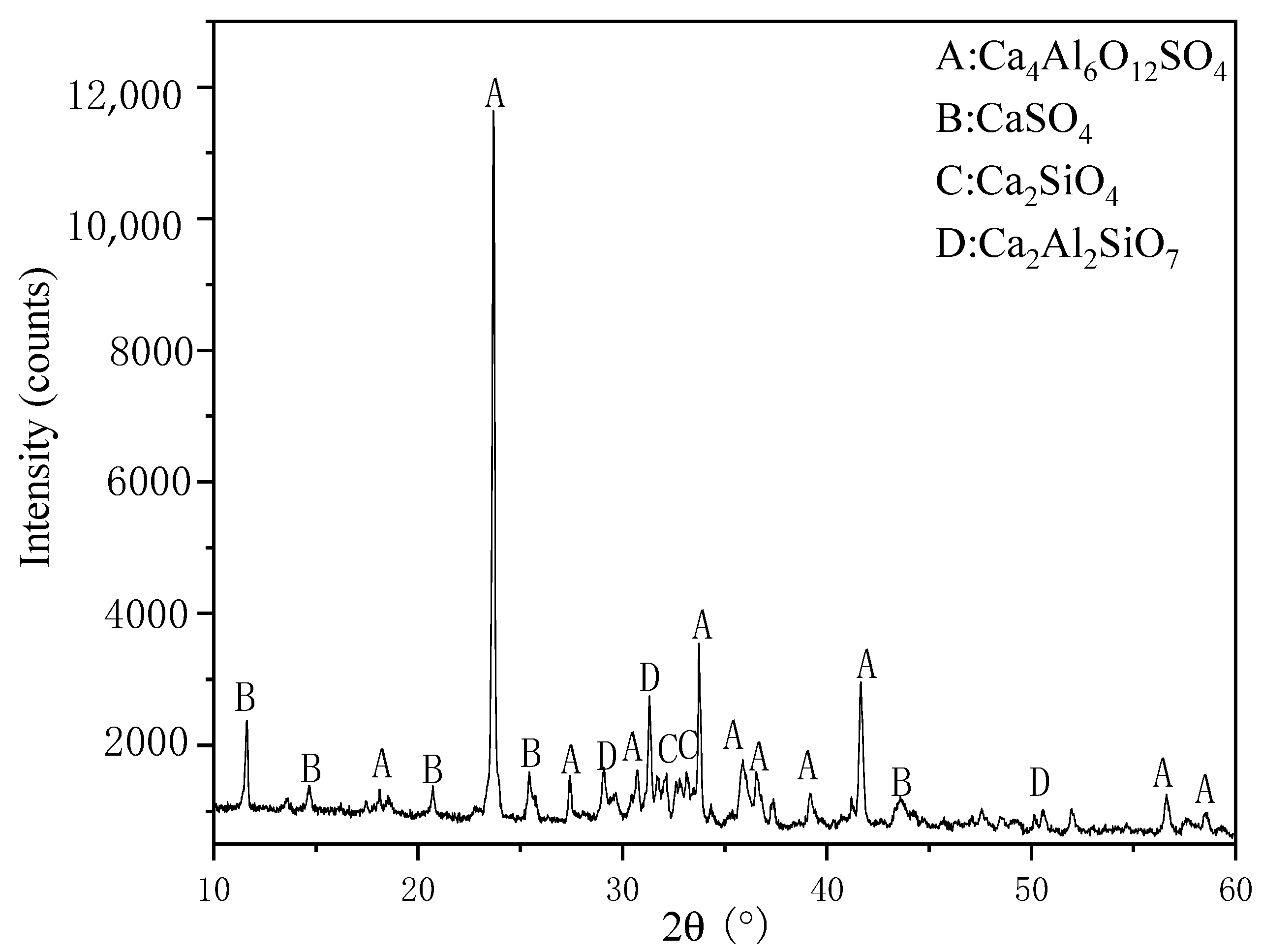
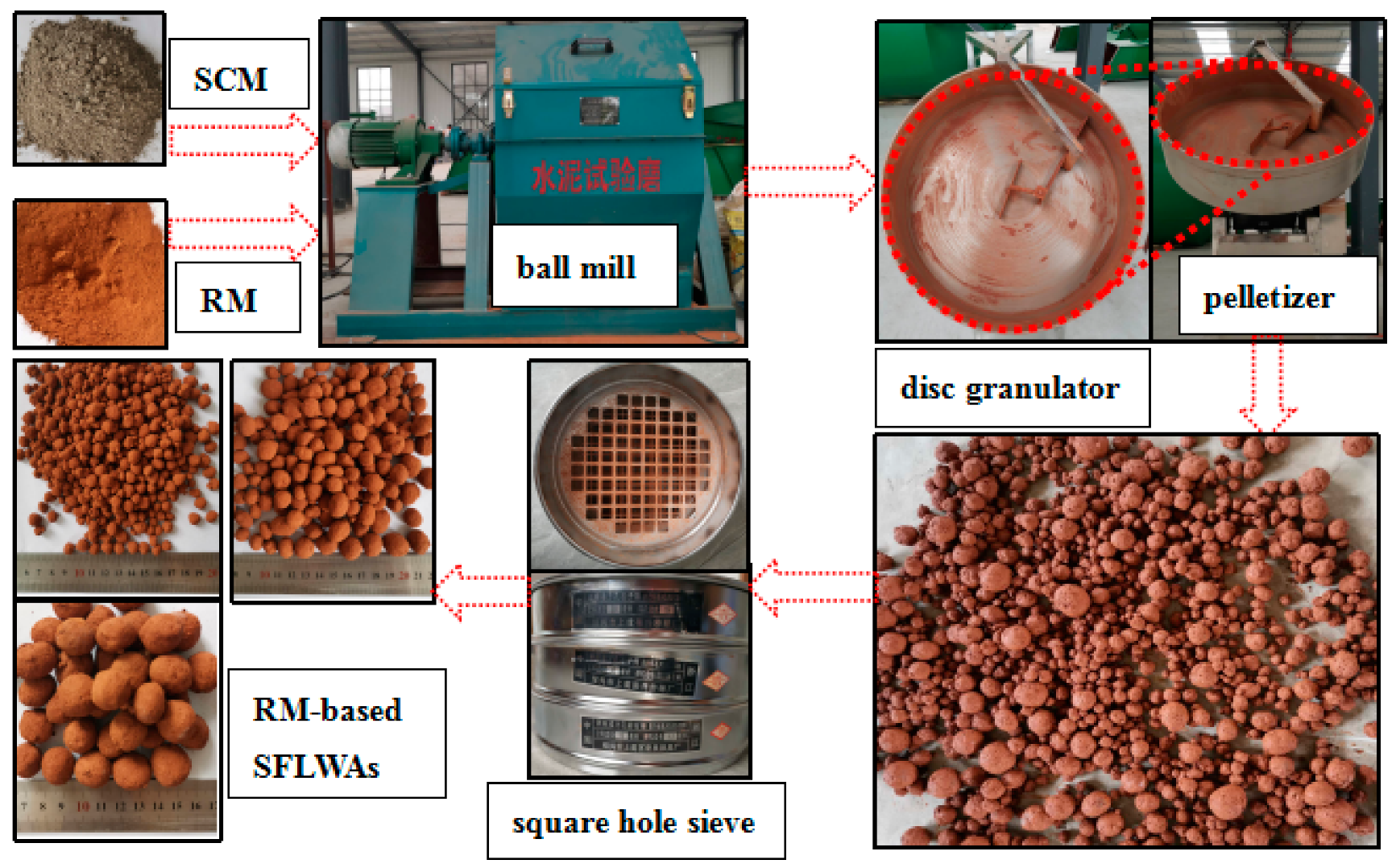


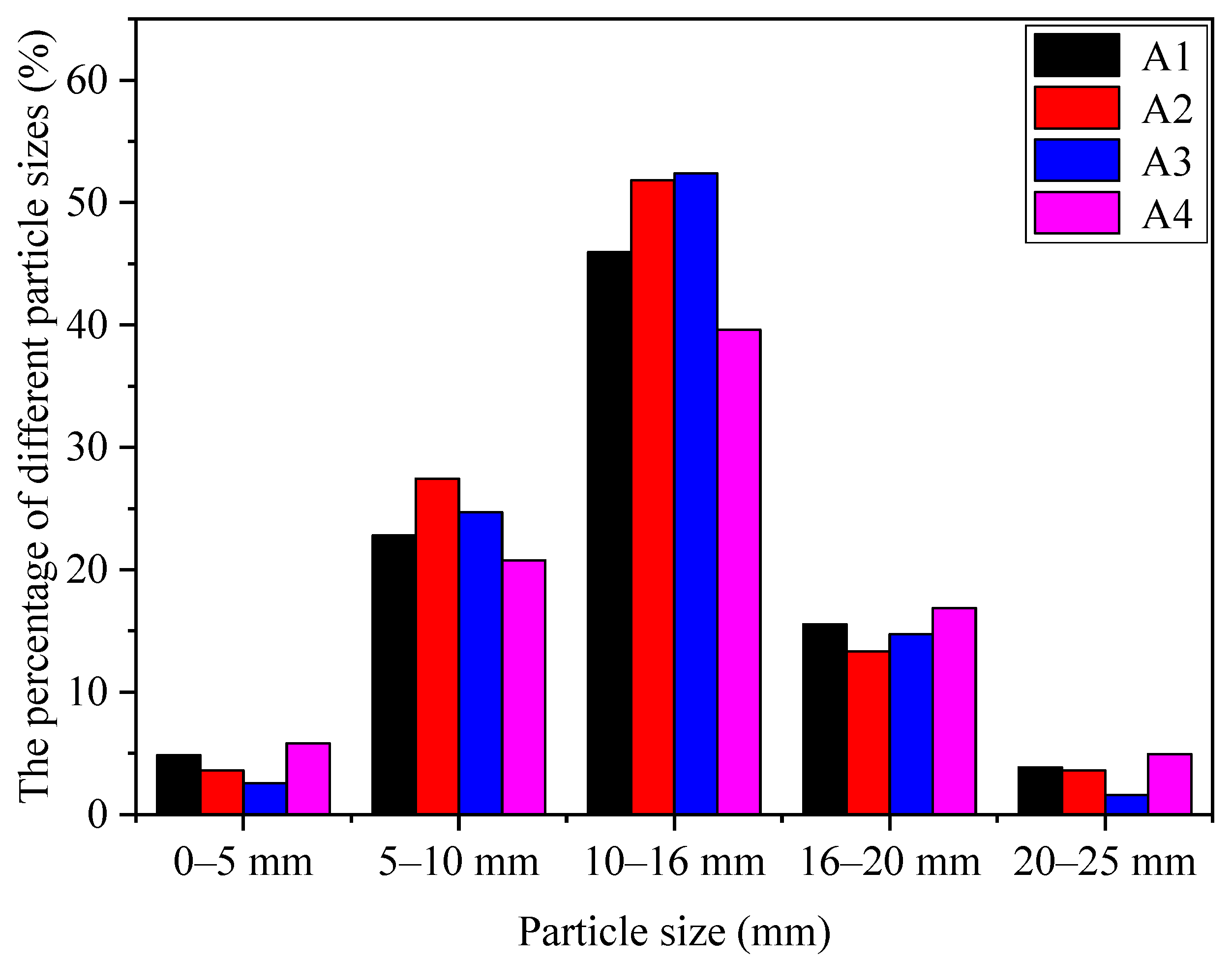

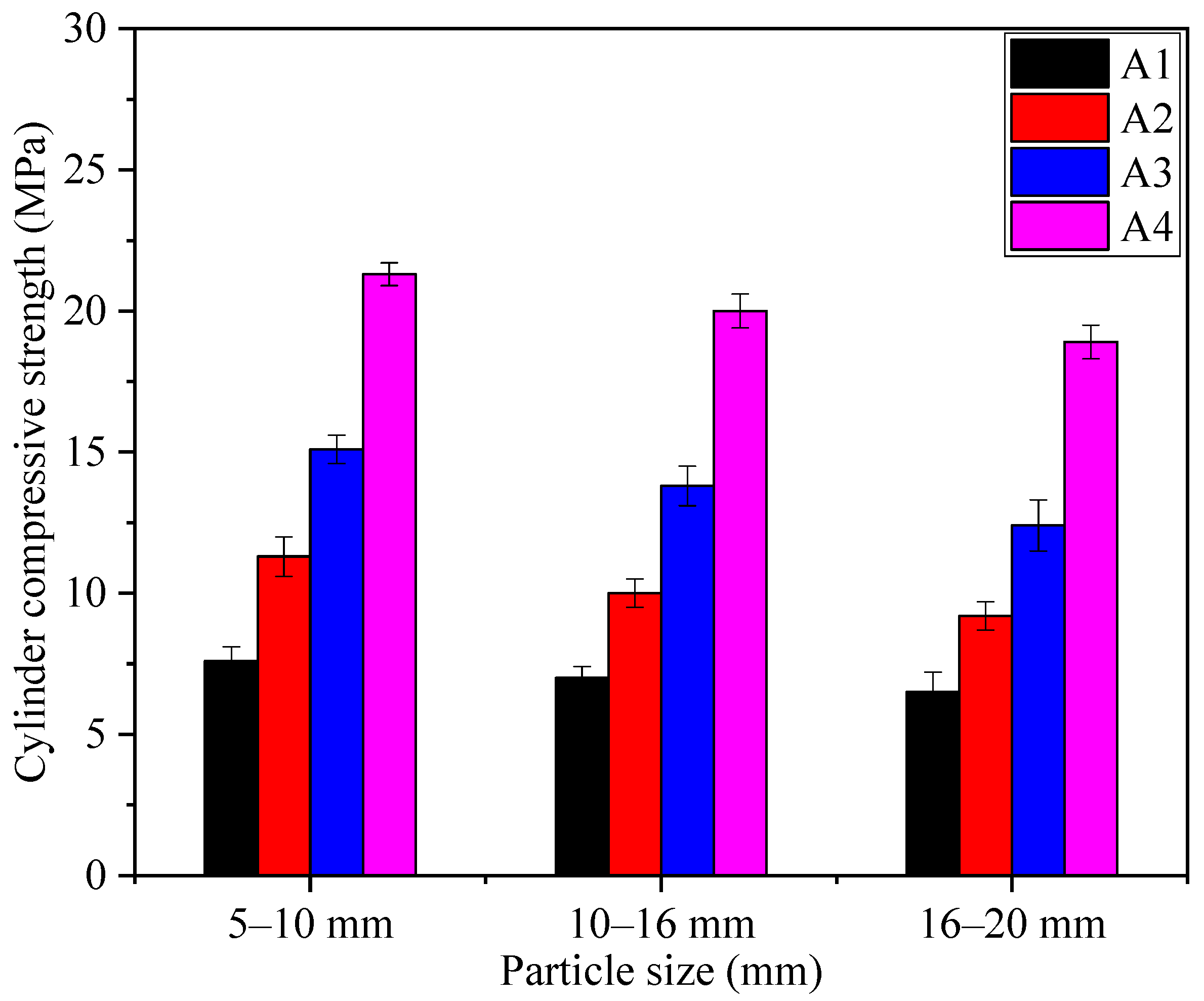


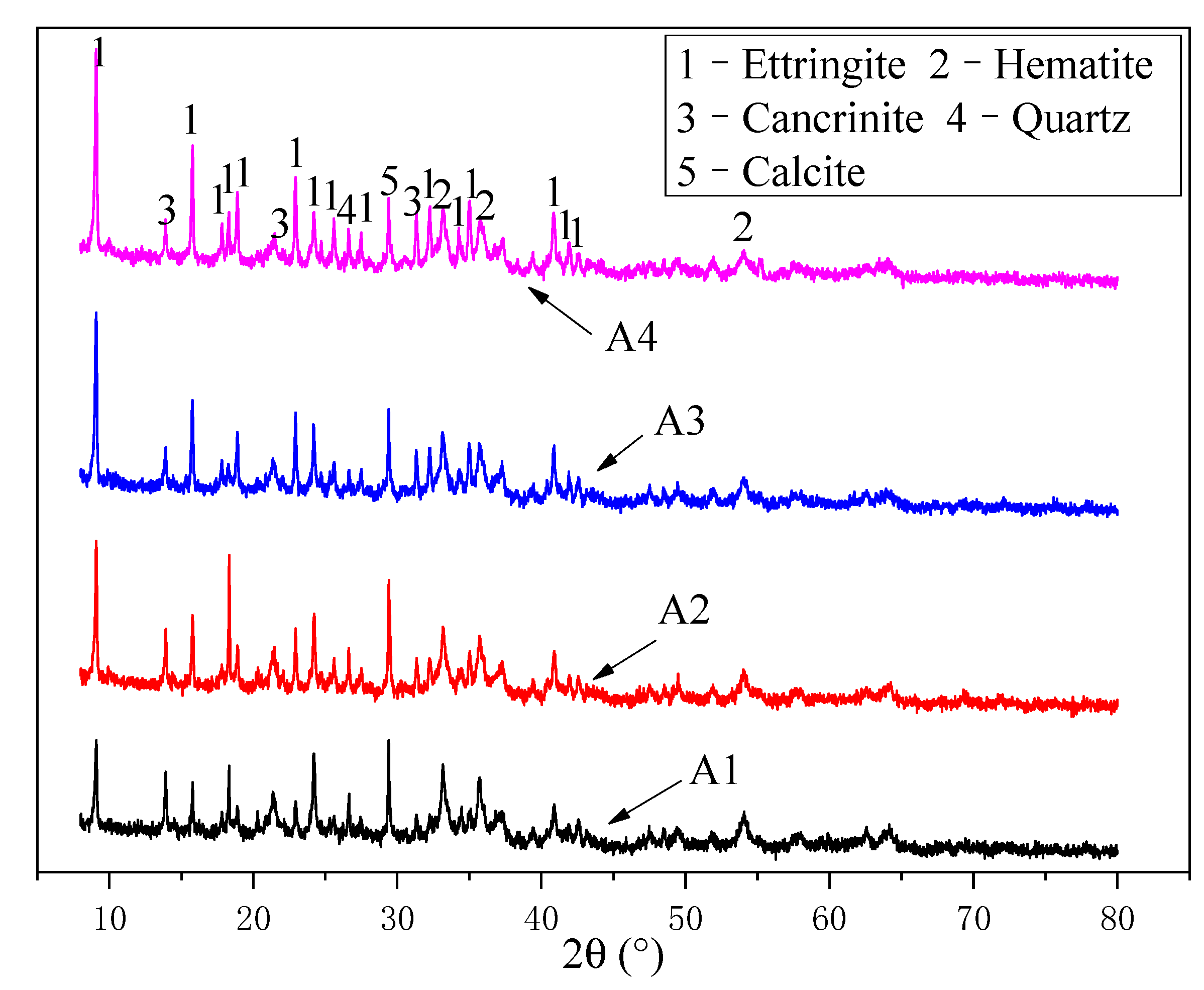

| Size Distribution (mm) | Dry Density (kN/m3) | Specific Gravity (kN/m3) | pH | Water Content (%) | Void Ratio | BET (m2/g) |
|---|---|---|---|---|---|---|
| 0.08–2.25 | 7.54 | 2.8 | 12.3 | 35.3 | 2.64 | 20.24 |
| CaO | SiO2 | Al2O3 | Fe2O3 | SO3 | MgO | TiO2 | R2O a | LOI b | |
|---|---|---|---|---|---|---|---|---|---|
| RM | 6.61 | 19.23 | 22.33 | 31.19 | 0.64 | 0.93 | 4.13 | 1.6 | 12.93 |
| FGD gypsum | 34.52 | 0.81 | 1.08 | 0.15 | 44.47 | 0.71 | 0.03 | - | 16.99 |
| Aluminum dust | 4.20 | 6.58 | 60.98 | 0.71 | 0.94 | 6.26 | 0.78 | 1.80 | 12.19 |
| Carbide slag | 65.12 | 2.52 | 1.50 | 0.29 | 0.51 | 0.20 | 0.02 | 0.02 | 29.63 |
| Cm | P | N | FGD Gypsum | RM | Aluminum Dust | Carbide Slag |
|---|---|---|---|---|---|---|
| 0.90 | 1.9 | 3.4 | 21.92 | 22.98 | 23.43 | 31.67 |
| 0.95 | 1.9 | 3.4 | 21.87 | 20.86 | 22.31 | 34.96 |
| 1.00 | 1.9 | 3.4 | 21.27 | 20.29 | 21.20 | 36.74 |
| 1.05 | 1.9 | 3.4 | 20.69 | 19.74 | 21.11 | 38.46 |
| CaO | SiO2 | Al2O3 | Fe2O3 | SO3 | MgO | TiO2 | R2O a | LOI b | |
|---|---|---|---|---|---|---|---|---|---|
| Proportion | 36.70 | 8.31 | 26.03 | 9.31 | 14.53 | 2.83 | 1.41 | 0.36 | 0.76 |
| RM (%) | Binder (%) | Water (%) | Time (min) | Diameter (mm) | Angle (°) | Critical Revolutions (rpm) | |
|---|---|---|---|---|---|---|---|
| A1 | 80 | 20 | 23 | 14 | 50 | 45 | 33 |
| A2 | 70 | 30 | 23 | 14 | 50 | 45 | 33 |
| A3 | 60 | 40 | 23 | 14 | 50 | 45 | 33 |
| A4 | 50 | 50 | 23 | 14 | 50 | 45 | 33 |
| Mortar Compressive Strength (MPa) | Flexural Strength (MPa) | Setting Time (min) | ||||||
|---|---|---|---|---|---|---|---|---|
| 1 d | 3 d | 28 d | 1 d | 3 d | 28 d | initial | final | |
| Binder material | 38.3 | 49.4 | 58.7 | 6.5 | 7.0 | 8.7 | 40 | 75 |
| Portland cement | 16.2 | 24.1 | 43.7 | 5.7 | 6.3 | 8.2 | 190 | 278 |
| Particle Size (mm) | A1 | A2 | A3 | A4 |
|---|---|---|---|---|
| 5–10 mm | 1922 | 1977 | 2033 | 2076 |
| 10–16 mm | 1925 | 1974 | 2035 | 2074 |
| 16–20 mm | 1919 | 1978 | 2036 | 2079 |
| Samples | Curing Ages | Ni | Cu | Zn | Mn | Cr | Cd | As | Pb |
|---|---|---|---|---|---|---|---|---|---|
| RM | - | 0.049 | 0.110 | 0.077 | 0.069 | 1.016 | 0.076 | 0.105 | 0.082 |
| Binder | - | 0.118 | 0.069 | 0.290 | 0.148 | 0.195 | 0.021 | 0.044 | 0.016 |
| A1 | 1 d | 0.005 | 0.016 | 0.053 | 0.053 | 0.470 | 0.011 | 0.025 | 0.025 |
| 3 d | 0.06 | 0.015 | 0.053 | 0.044 | 0.362 | 0.011 | 0.022 | 0.025 | |
| 28 d | 0.005 | 0.013 | 0.054 | 0.043 | 0.196 | 0.011 | 0.019 | 0.024 | |
| A2 | 1 d | 0.005 | 0.014 | 0.055 | 0.054 | 0.402 | 0.011 | 0.026 | 0.025 |
| 3 d | 0.006 | 0.024 | 0.056 | 0.041 | 0.289 | 0.011 | 0.021 | 0.023 | |
| 28 d | 0.005 | 0.013 | 0.056 | 0.039 | 0.137 | 0.010 | 0.018 | 0.021 | |
| A3 | 1 d | 0.005 | 0.013 | 0.056 | 0.054 | 0.291 | 0.011 | 0.036 | 0.026 |
| 3 d | 0.003 | 0.012 | 0.057 | 0.040 | 0.183 | 0.010 | 0.027 | 0.025 | |
| 28 d | 0.002 | 0.012 | 0.057 | 0.038 | 0.104 | 0.010 | 0.017 | 0.024 | |
| A4 | 1 d | 0.001 | 0.011 | 0.057 | 0.054 | 0.175 | 0.010 | 0.034 | 0.029 |
| 3 d | ND | 0.011 | 0.058 | 0.039 | 0.106 | 0.010 | 0.031 | 0.028 | |
| 28 d | ND | 0.011 | 0.058 | 0.038 | 0.083 | 0.010 | 0.028 | 0.027 | |
| Leaching limit value | <5 | <100 | <100 | <100 | <15 | <100 | <5 | <5 | |
| Reference | Size (mm) | Raw Material | Binder | Water Content (wt.%) | Additive | BD (kg/m3) | WAR (wt.%) | CCS (MPa) | Method of Curing |
|---|---|---|---|---|---|---|---|---|---|
| In this work | 10–16 | Red Mud | Solid waste-based Binder | 23 | No additive | 900–1000 | 9.35–12 | 11.3 | At room tempera-ture |
| [37] | 4–10 | Class-F FA, GGBFA | PC and Na2SiO3 | - | HP and NaOH | 765–915 | 13.7–25.6 | 4.73–8 | RH 60% at 23 °C |
| [38] | 4–16 | Class-F FA | PC CEM I 42.5 R | 23–27 | PPF and CR | 1000 | 24–28 | 3.53–4.19 | RH 80% at 20 °C |
| [39] | 10–12.5 | Class-F FA | Bentonite | 25 | NaOH | 950 | 16.39 | 10.22–14.51 | Hot air oven at 100 °C |
| [40] | 4.75–19 | Class-F FA | PC CEM I 42.5 R | 22–25 | - | 789 | - | 3.7 | RH 70% at 25 °C |
| [41] | 4.76–12.7 | Class-F FA | PC CEM I | - | - | 857–972 | 20–35 | 6–8.57 | - |
Publisher’s Note: MDPI stays neutral with regard to jurisdictional claims in published maps and institutional affiliations. |
© 2021 by the authors. Licensee MDPI, Basel, Switzerland. This article is an open access article distributed under the terms and conditions of the Creative Commons Attribution (CC BY) license (http://creativecommons.org/licenses/by/4.0/).
Share and Cite
Wang, G.; Zhang, C.; Wang, W.; Wu, S.; Li, J.; Wang, X.; Wu, C. Preparation and Physico-Chemical Performance Optimization of Sintering-Free Lightweight Aggregates with High Proportions of Red Mud. Materials 2021, 14, 218. https://doi.org/10.3390/ma14010218
Wang G, Zhang C, Wang W, Wu S, Li J, Wang X, Wu C. Preparation and Physico-Chemical Performance Optimization of Sintering-Free Lightweight Aggregates with High Proportions of Red Mud. Materials. 2021; 14(1):218. https://doi.org/10.3390/ma14010218
Chicago/Turabian StyleWang, Guan, Chao Zhang, Wenlong Wang, Shuang Wu, Jingwei Li, Xujiang Wang, and Changliang Wu. 2021. "Preparation and Physico-Chemical Performance Optimization of Sintering-Free Lightweight Aggregates with High Proportions of Red Mud" Materials 14, no. 1: 218. https://doi.org/10.3390/ma14010218
APA StyleWang, G., Zhang, C., Wang, W., Wu, S., Li, J., Wang, X., & Wu, C. (2021). Preparation and Physico-Chemical Performance Optimization of Sintering-Free Lightweight Aggregates with High Proportions of Red Mud. Materials, 14(1), 218. https://doi.org/10.3390/ma14010218






